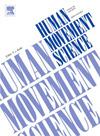Inter-subject variability in muscle synergies during squatting movements
IF 1.9
3区 心理学
Q4 NEUROSCIENCES
引用次数: 0
Abstract
This study investigated muscle synergies during squats, focusing on the individual variability in motor control strategies. Sixteen healthy young adults performed 20 squats at a consistent speed. Muscle synergies were extracted using non-negative matrix factorization, followed by k-means clustering and discriminant analysis to categorize similar muscle synergies. The analysis revealed an average of 3.3 ± 0.4 muscle synergies per squat. Further clustering analysis identified six distinct types of muscle synergies across subjects. Among them, one synergy involving trunk, hip, and knee extensors was universal across all subjects, representing a fundamental motor strategy for successful squat execution. In contrast, the remaining synergies varied across subjects, exhibiting mutual exclusivity, where individuals systematically select one synergy type or another during the same squatting phase. These findings demonstrate inter-subject variability in muscle synergies during the squat and underscore the coexistence of universal and individualized muscle synergies in human motor control, providing practical insights for designing personalized squat training and rehabilitation strategies guided by neuromechanical principles.
下蹲运动中肌肉协同作用的主体间变异性。
本研究调查了深蹲期间的肌肉协同作用,重点关注运动控制策略的个体差异。16名健康的年轻人以一致的速度做了20次深蹲。使用非负矩阵分解提取肌肉协同效应,然后使用k-means聚类和判别分析对相似的肌肉协同效应进行分类。分析显示,每次深蹲平均3.3±0.4的肌肉协同作用。进一步的聚类分析确定了六种不同类型的肌肉协同作用。其中,躯干、髋关节和膝关节伸肌的协同作用在所有受试者中普遍存在,代表了成功深蹲执行的基本运动策略。相比之下,其余的协同作用在受试者之间是不同的,表现出互他性,在同一个深蹲阶段,个体系统地选择一种或另一种协同作用类型。这些发现证明了深蹲过程中肌肉协同作用的主体间变异性,并强调了人类运动控制中普遍和个性化肌肉协同作用的共存,为设计个性化深蹲训练和基于神经力学原理的康复策略提供了实用的见解。
本文章由计算机程序翻译,如有差异,请以英文原文为准。
求助全文
约1分钟内获得全文
求助全文
来源期刊

Human Movement Science
医学-神经科学
CiteScore
3.80
自引率
4.80%
发文量
89
审稿时长
42 days
期刊介绍:
Human Movement Science provides a medium for publishing disciplinary and multidisciplinary studies on human movement. It brings together psychological, biomechanical and neurophysiological research on the control, organization and learning of human movement, including the perceptual support of movement. The overarching goal of the journal is to publish articles that help advance theoretical understanding of the control and organization of human movement, as well as changes therein as a function of development, learning and rehabilitation. The nature of the research reported may vary from fundamental theoretical or empirical studies to more applied studies in the fields of, for example, sport, dance and rehabilitation with the proviso that all studies have a distinct theoretical bearing. Also, reviews and meta-studies advancing the understanding of human movement are welcome.
These aims and scope imply that purely descriptive studies are not acceptable, while methodological articles are only acceptable if the methodology in question opens up new vistas in understanding the control and organization of human movement. The same holds for articles on exercise physiology, which in general are not supported, unless they speak to the control and organization of human movement. In general, it is required that the theoretical message of articles published in Human Movement Science is, to a certain extent, innovative and not dismissible as just "more of the same."
 求助内容:
求助内容: 应助结果提醒方式:
应助结果提醒方式:


